Balthus, Cats & Girls
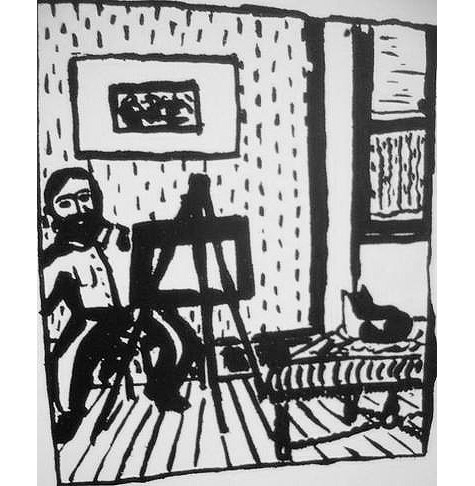
The best part, perhaps the most genuine component of the Balthus: Cats and Girls show now at the Met is its coda, a separate room labeled Mitsou. Based on his found and lost stray cat—these beautiful 40 pen and ink drawings resemble woodcuts, and show a precocious talent, as they were made when Balthus was just 11 years old.
42nd on Warren
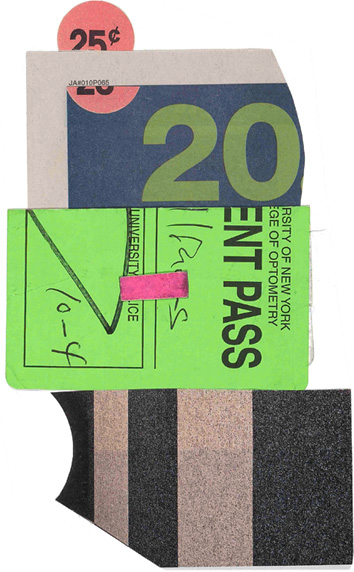
One of my pieces, 42nd 5th & 6th, a collage made from ephemera I found on that street, will be in Well Put Together: The Art of Collage & Assemblage, a group show at the CCCA Gallery, 209 Warren Street, Hudson, NY. The opening reception is April 6 from 5-7pm. The show runs through May 17.
A Delightful Discovery at the Metro Show: Larry Lewis

Meandering through the mazes of booths at the Metro Show this afternoon, I was arrested by an image—a bold, graphic colorful portrait of a woman staring frontally, and assumed it was by Seymour Chwast. But as I got closer and walked around this gallery booth, I learned the work was by a little known artist from New Canaan, Connecticut, Larry Lewis. Lewis who was born in 1919, and lived a relatively hermetic existence in the house he grew up in, spent his free time—when not working as a corporate secretary—making art. He had formal training at the Art Students League, and had a few shows of his paintings, but created this large body of collage art for himself. Working on these pieces privately, he did not show them to many people; perhaps maybe only his niece.
Over many years, and especially from the 60’s until he died in 2004, he delighted in using the Xerox machine to blow up vintage newspaper ads, and movie ephemera as the basis for books and books he created of tabloid-sized pop collages, exuberant in color and bold graphically, with interesting juxtapositions and humor. This trove of work—redolent of Joseph Cornell, Stuart Davis and of course, Warhol—has not yet been widely seen—beyond New Canaan’s Silvermine Arts Center—where there was a show of his work in 2011.
When Lewis died, he left all the art and other contents of his home to his niece, who meticulously went about preserving, documenting and finding a professional venue for her uncle’s work. This weekend at the Metro Show, New Haven’s Giampietro Gallery is formally introducing the New York art world to Larry Lewis’ work. Giampietro will be putting many of his books online in the coming weeks, and plans to show more of his work in the next few years.
The Master of the Avenue B School of Art
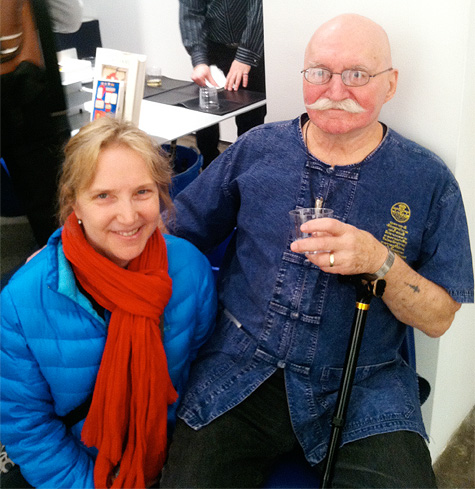
What a thrill it was tonight: Not only to be in a room arrayed with an abundance of amazing collages by one of my idols, John Evans, but to actually meet him! And to tell him that he has been a great influence and inspiration for my own collage practice. He was holding court at the Pavel Zoubok Gallery in Chelsea, at a reception celebrating the publication of a book of his works from the year 1984.
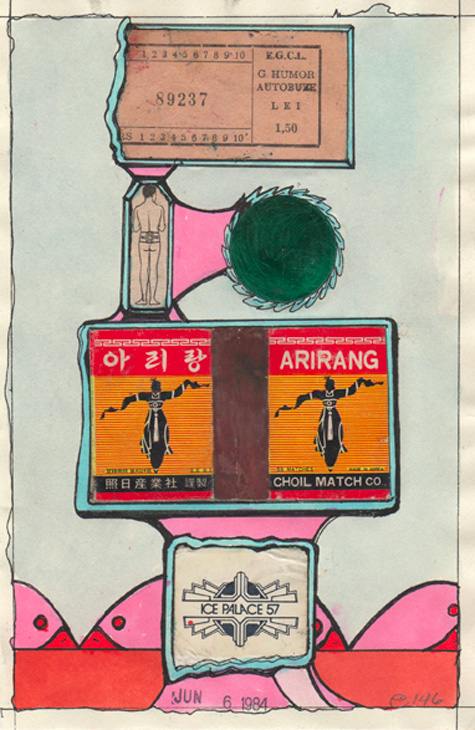
For decades, Evans made daily collages in bound books on heavy paper, applying collected gems of ephemera from his East Village neighborhood and life to grounds of watercolor wash, bound by hand-drawn borders—each page date-stamped. Ducks were his Ninas, and they were all lined up at the gallery this evening, as a continuous motif along the bottoms of his works. Intimate in size, each piece is about 8” x 5”; each page has been carefully extracted by X-acto knife and metal ruler from Evans’ notebooks.
People love his work for different reasons: Some are attracted to the dates—Valentine’s day, today, the Ides of March, their birthdays. Others love to interrogate the jewel-like content—stamps, ornate fabric swatches, candy foils, ads, cookie fortunes, found notes, packaging labels. Then there is his signature formalism, the way he incorporates pasted objects with paint, ink,color and wit that magically coalesce into totemic sculpture, akin to the way Leger made 2-D look 3-D.
I also learned John Evans is a father of twins!
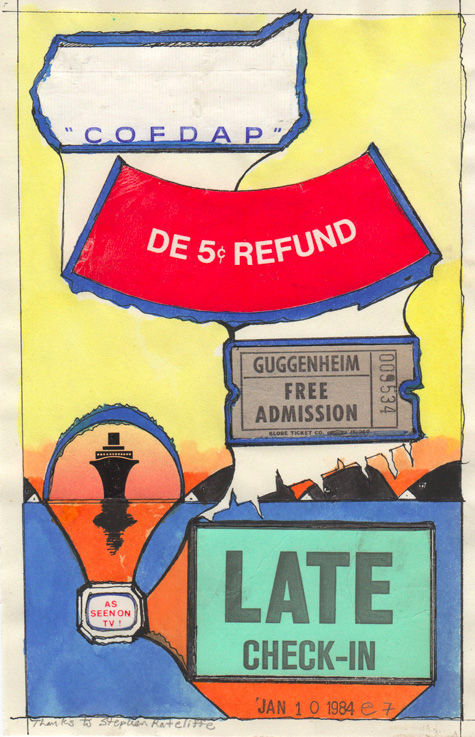
Museum der Dinge (Museum of the Thing)
After walking around Berlin and getting lost or detoured for hours, once we found this mecca for objets, there was much loud mooing and cooing in the otherwise staid aisles.
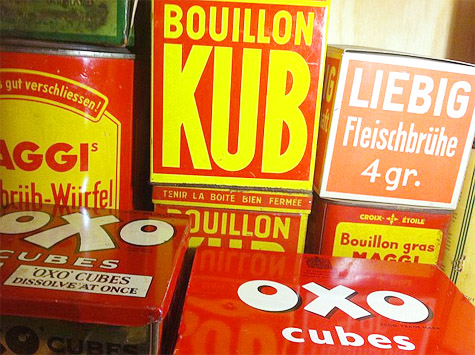
Displaying things simply and not didactically, the Museum der Dinge features collections of everything from the mundane to the sublime: Braun home appliances from the Sputnik era, portrait busts in wood, plastic and metal, Mona Lisas in doll and puzzle format, portable fans of all eras, items that happen to be only black and yellow, illustrated biscuit tins, the Olivetti Valentine.

![]()

Walking the vast loft gallery in boustrophedon to see every last dinge, they ask you to ask yourself, “Ist das kitsch or ist das schoen?”
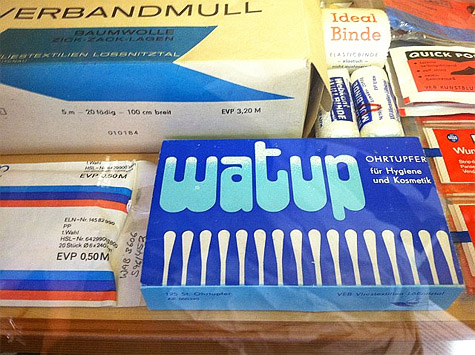
A Summer Ramble @ Sohn Fine Art

An homage to the idyllic A-B-A-B, 15-stanza verse by the passionate polymath poet and sometime Berkshire resident, William Cullen Bryant, this group show features my collage print, “Summer Splash,” and the works of 11 other artists.
The show, running from June 24 - August 22, will be at the Sohn Fine Art Gallery in Stockbridge, MA.
Please join me at the opening reception, Saturday July 2, 5 - 8 pm.
Salaam Warren Street
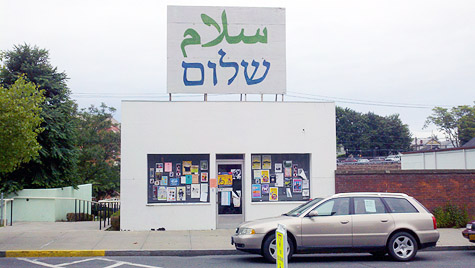
Saturday evening, Hudson New York was still tinglng after the festivities of earlier in the day, when it celebrated the Elks Flag Day Parade. Forest green Portosans lined the boulevards, and small American flags adorned the tops of parking meters. Candy and gum wrappers and the splayed remains of firecrackers dotted the sidewalks. The convulsions of fireworks could be heard downtown.
We went to the Hudson Opera House for a show about the main drag, Warren Street. Some forty artists participated, and several works have lingered in my memory. At the core was “The Warren Street Project,” a striking black and white series of documentary photographs of historic buildings by Lynn Davis. I remember seeing them originally at the Mark McDonald Gallery. There, along the periphery of the upstairs balcony, I enjoyed contemplating hundred of her photographs, engaged by their quiet definition of the built environment of this once grand city. If they are not in a book, they should be.
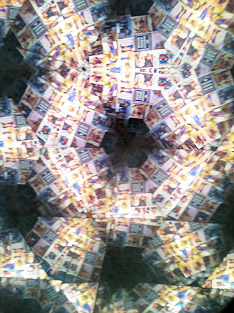 When you enter the show at the Opera House, you are confronted by a sculptural critter that admits you into its kaleidoscopic snout, a fun and mesmerizing installation by Bruno Pasquier-Desvignes. There is Dan Rupe’s technicolor portrait of the first place I ever ate in Hudson, the Columbia Diner. In those days, all of Hudson appeared in shades of grey. A small, lovely watercolor called “Space 360” by Nancy Hagin captures the essence of an elegant brownstone.
When you enter the show at the Opera House, you are confronted by a sculptural critter that admits you into its kaleidoscopic snout, a fun and mesmerizing installation by Bruno Pasquier-Desvignes. There is Dan Rupe’s technicolor portrait of the first place I ever ate in Hudson, the Columbia Diner. In those days, all of Hudson appeared in shades of grey. A small, lovely watercolor called “Space 360” by Nancy Hagin captures the essence of an elegant brownstone.
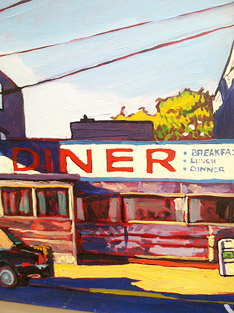
![]()
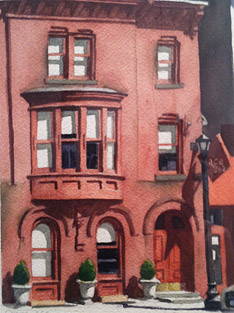 And of course, there is a streetscape by Earl Swanigan, Mississippi transplant and Hudson artist. His painting, populated by walking dogs, is a special part of Warren Street on the block of his studio.
And of course, there is a streetscape by Earl Swanigan, Mississippi transplant and Hudson artist. His painting, populated by walking dogs, is a special part of Warren Street on the block of his studio.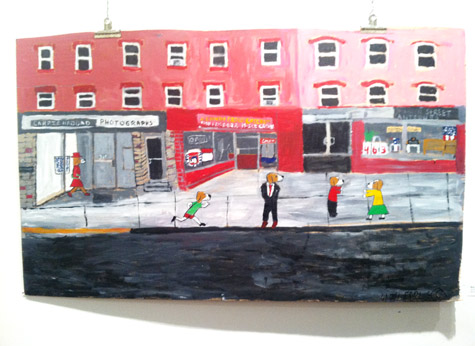
Filled with visual treats, the real Warren Street, looking down to the river, continues to be a view from the past—especially at dusk.
Black and White and Read All Over the Armory
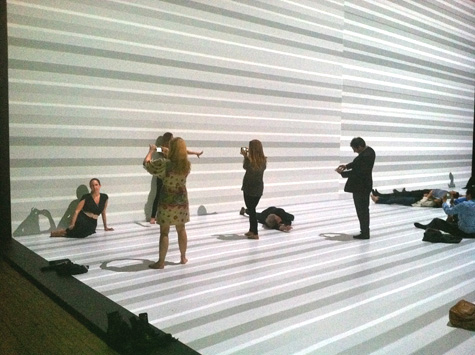
“Hey, it’s like being inside a TV, Mama,” my son said. Ryoji Ikeda’s spectacular installation at the Park Avenue Armory did remind some of us of the horizontal and vertical controls that cured the errant scan lines of yesteryear.
Upon entering the massive yet elegant Grand Marnier lit 19th century building for the opening reception, we saw the very shy, somewhat diminutive artist in sunglasses—How could this work of his be so colossal, extroverted, and commandingly powerful?
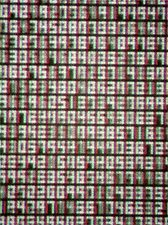
![]()
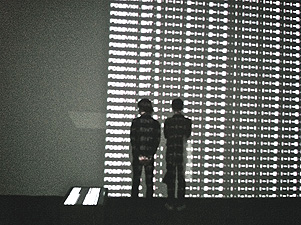
Ikeda’s the transfinite is kind of like God for atheists. An expression of mathematical data describing the infinite, it is immediate—overwhelming yet comforting. Projections of parallel black and white lines and grids of numbers are perpendicular to the floor—a clean white beach—where people walk shoeless or recline to confer, dance and contemplate. Occasional plinths dot the landscape, each topped with displays of data, white type rushing against black ground, mutating dynamically like a river you want to arrest with your touch. For a textile designer, it is seeing patchworks of stripes and extreme close-ups of plaids rushing in contrasts.
The transfinite is also the voice of mathematical output, accompanied by its own mewing resonant sound waves, like chanting mantras. The Armory’s Drill Hall is transformed by its immersive starkness yet warmth, and we were filled with meditative awe and the experience of communion.
From Hitcher . . . to Stitcher
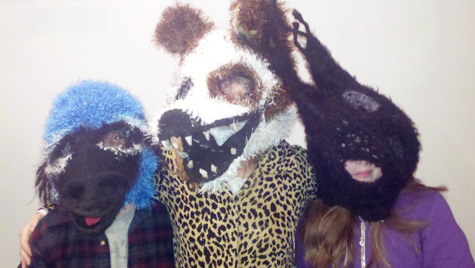 Huckleberry DelSignore, an artist in residence at the Berkshire Museum greeted us this past Saturday at the opening of her show, Concepts in Crochet. Installed in an upstairs nook was a collection of organic, pop fiber critter masks she made, amidst a few extruded polyhedral tents. Huck told us that most of the masks—which are easy to slide on and inhabit—were crocheted onto helmets.
Huckleberry DelSignore, an artist in residence at the Berkshire Museum greeted us this past Saturday at the opening of her show, Concepts in Crochet. Installed in an upstairs nook was a collection of organic, pop fiber critter masks she made, amidst a few extruded polyhedral tents. Huck told us that most of the masks—which are easy to slide on and inhabit—were crocheted onto helmets.
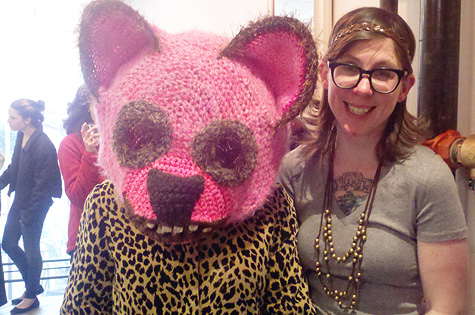
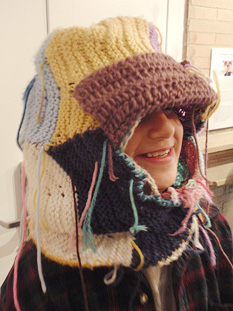
![]()
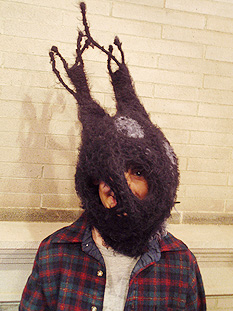 We had a blast, trying on all the masks and posing. Soft, ample and not at all itchy, the one-size-fits-all masks are mossy and complex—looking in. They offer the wearer a secure hideaway that disarms viewers by making them laugh.
We had a blast, trying on all the masks and posing. Soft, ample and not at all itchy, the one-size-fits-all masks are mossy and complex—looking in. They offer the wearer a secure hideaway that disarms viewers by making them laugh.
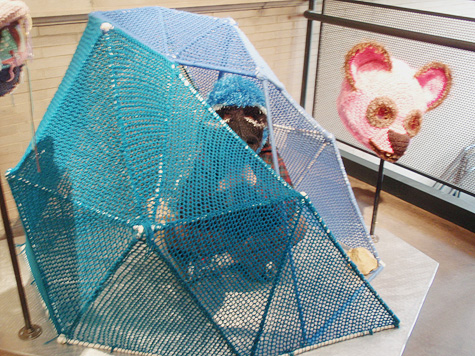 The blue yarn latticed tents—framed with metal armatures—were large enough to admit small people. Believe it or not, Huck said, she uses the same stitch for all the work in the show. She has also hitchhiked –back and forth across country to California several times—crocheting along the way.
The blue yarn latticed tents—framed with metal armatures—were large enough to admit small people. Believe it or not, Huck said, she uses the same stitch for all the work in the show. She has also hitchhiked –back and forth across country to California several times—crocheting along the way.
Escherphilia
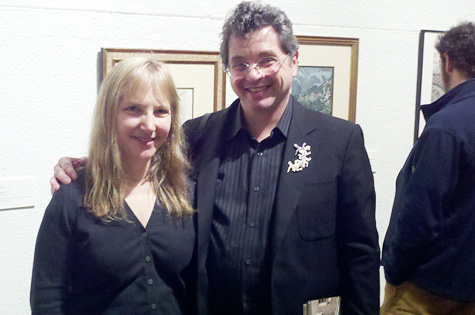
I counted the days until the opening of M.C. Escher: Seeing the Unseen at the Berkshire Museum in Pittsfield, MA. The show contains his classics and some of the rarest Eschers ever in one place—original pencil studies, lithographs, metamorphic scrolls, woodblocks and tzchotkes collected by him, including tiles he hand-painted to make his own tessellation patterns. Black-lit psychedelic posters, applications and appropriations of his work on record albums, magazines, and even polyester shirts convey the dichotomy of Escher as pop artist or master printmaker.
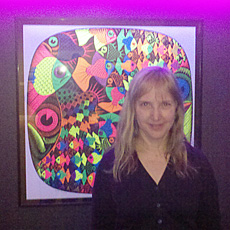 Escher, as you know is one of my core group of influences. In seventh grade I did a lengthy research paper on him, which I presented to a group of novitiates. I was and am still very entranced by his approach—by Escher’s interest in how we “see” things, his sublime technical prowess in printmaking and drawing, and his apprehension of the natural world. And I am awed by his ability to illuminate and show the continuum to infinity, to illustrate the merger of opposites: sea and sky, day and night, good and evil, two dimensions and three, order and chaos (Order and Chaos, a still life with a giant crystal at its core is one of my favorites.) Escher starts in the physical realm but takes us to the philosophical one. His work is transcendent.
Escher, as you know is one of my core group of influences. In seventh grade I did a lengthy research paper on him, which I presented to a group of novitiates. I was and am still very entranced by his approach—by Escher’s interest in how we “see” things, his sublime technical prowess in printmaking and drawing, and his apprehension of the natural world. And I am awed by his ability to illuminate and show the continuum to infinity, to illustrate the merger of opposites: sea and sky, day and night, good and evil, two dimensions and three, order and chaos (Order and Chaos, a still life with a giant crystal at its core is one of my favorites.) Escher starts in the physical realm but takes us to the philosophical one. His work is transcendent.
Prior to the opening reception, Jeffrey Price, one of the foremost Escher hunters, collectors, dealers and experts, gave an insightful overview of how Escher’s family life, mentoring teachers and travels informed his decision to do what he loved—be an artist. At the show, I got to probe Jeffrey for more details about Escher’s life and work, and share Escherphilia.